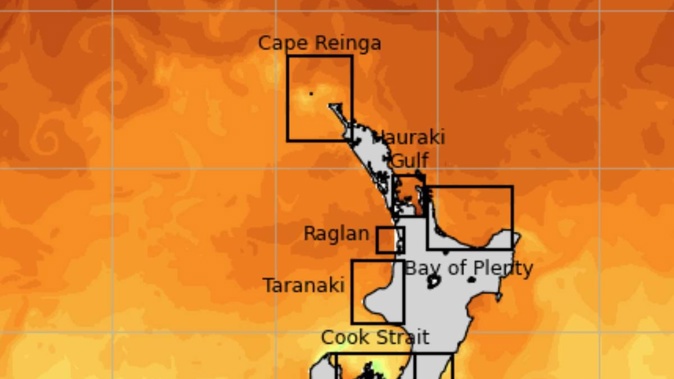
Meteorologists have been surprised to see New Zealand engulfed by yet another summer marine heatwave, which is likely to worsen over coming days.
On a day tipped to bring some of the hottest temperatures of summer, Niwa forecaster Ben Noll said our coastal waters were also running unusually hot.
“Our sea surface temperatures are cooking with gas at the moment, at anywhere between 1C and 2C above average around the North Island and the northern and eastern South Island,” he said.
“With the pattern we’re in, I’d expect pretty substantial warming going through this weekend.”
The MetService-hosted Moana Project’s marine heatwave forecast picked “strong” conditions for the North Island’s upper west and eastern coasts over the next seven days – with “severe” conditions off Hawke’s Bay.
/cloudfront-ap-southeast-2.images.arcpublishing.com/nzme/DWJRM5UOGJDPLI3TYA6LTOYPM4.jpg) Source / MetOcean Solutions
Source / MetOcean Solutions
Although a southerly front forecast to sweep up early next week could help cool off waters near the South Island and lower North Island, seas at the top of the country might not get a reprieve.
Noll said the warmer seas would be one driving factor in the heat about this week.
“Those overnight minimum temperatures are going to be uncomfortably warm in many regions in coming days – think the mid to late teens – and this heatwave will definitely be affecting that.”
/cloudfront-ap-southeast-2.images.arcpublishing.com/nzme/GEJIXRRABVFVFHCCDLEJMNVNVQ.jpg) Source / MetOcean Solutions
Source / MetOcean Solutions
While warmer seas might seem great for beachgoers, relentless marine heatwaves have been linked to a range of dramatic, cascading environmental impacts below and above water over the past decade - from melting glaciers to mass bleaching events, kelp losses and disruptions to the feeding and breeding patterns of our resident blue whales.
They’ve also added energy to subtropical-flavoured storm systems that have regularly featured over what have been New Zealand’s three hottest years on record.
/cloudfront-ap-southeast-2.images.arcpublishing.com/nzme/4AH7MW2MDVF4TLJEHBXRRE3ESY.jpg) Source / MetOcean Solutions
Source / MetOcean Solutions
Noll said this month’s marine heatwave conditions had come somewhat as a surprise, given the classic patterns of El Nino didn’t tend to favour their development.
“But this El Nino has been full of surprises, and in the context of a changing climate, we’re seeing things that we didn’t in the past.”
Further afield, moderate-to-strong ocean heatwave conditions were being observed over thousands of kilometres between eastern Australia, New Caledonia and eastward to the Chatham Islands.
This, along with ongoing ocean warmth across the east and west of the tropical Pacific, likely contributed to New Zealand’s damp Christmas and New Year weekends, while also influencing local temperatures over December.
This week, climate scientist Professor Jim Salinger reported it’d been the wider New Zealand marine region’s warmest 12 months in more than 150 years, with ocean heatwaves likely to grow longer, stronger and more frequent with climate change.
Scientists have warned local average sea temperatures could rise by 1.4C within four decades – and almost 3C by the century’s end.
That would mean that, by mid-century, we could be facing 260 days of marine heatwaves per year – and 350 days by 2100 – compared with the 40-odd days we see now.
/cloudfront-ap-southeast-2.images.arcpublishing.com/nzme/ILSPZZX6YYEBWRRNIGJOG4RRLU.jpg) A bleached sea sponge in Fiordland, where sea temperatures last year soared to 5C above normal. Image / Victoria University
A bleached sea sponge in Fiordland, where sea temperatures last year soared to 5C above normal. Image / Victoria University
For some regions such as the southern tip of the South Island, Niwa-led research has found, there was a high chance that marine heatwaves could start to last more than a year.
That made it all the more important to understand where our ocean species might be able to find shelter, Niwa physical oceanographer Dr Erik Behrens said.
“New Zealand’s marine zone likely contains several spots that are buffered from warming seas due to unique oceanographic conditions, as these regions are impacted by internal waves and changing ocean currents,” Behrens said.
“We need fine-scale vulnerability assessments of a nation’s coastal waters, including identification of climate refugia due to internal waves, and how these refugia overlap with species of concern.”
Behrens said New Zealand’s oceans were warming twice to three times the global rate - but accurately defining and predicting ecological impacts of marine heatwaves required more research.
“This is a glaring knowledge gap, and a challenge given the variability in marine heatwave manifestation and in organism resilience.”
Jamie Morton is a specialist in science and environmental reporting. He joined the Herald in 2011 and writes about everything from conservation and climate change to natural hazards and new technology.
Take your Radio, Podcasts and Music with you









